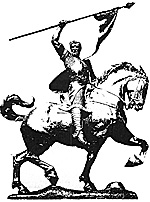
The last half of the 11th century offers wide scope for those who choose to wargame the early medieval period. Compressed into a span of 33 years are the dramatic events surrounding the Norman invasion of England in 1066, as well as the battles of the First Crusade that culminated in the capture of Jerusalem in 1099. These campaigns stand as historic landmarks of a time when the Dark Ages drew to a close and the Old World began to emerge from long isolation.But military events also held center stage in another arena.
An equestrian statue of the Cid Campeador by Anna Hyatt Huntington is a memorial to Ruy Diaz de Bivar of Eleventh Century Spain. Courtesy of the Hispanic Society ofAmerica. N. Y Public Library Picture Collection.
In the Iberian peninsula, the tide of Moorish advance had been stopped and the Christian states that had been flung back to the north were asserting growing strength. In the late 1000's, the Christian conquest of Spain, the Reconquista, was beginning to take shape. Although 400 more years would pass before the last Moorish stronghold on the peninsula would fall, the second half of the 11th century would witness some of the most significant strokes and countetstrokes of that long, fiercely fought contest. And the times would provide one of history's great national heroes -- Rodrigo Diaz -- known to Spain and the world as El Cid.
Militarily, this period in Spanish history offers great diversity in troop types and weapons, as well as in potential alliances. There appears to have been surprisingly little difference between the troops of Christian and Moorish states. But the Spain of this day was unique- at least in Europe- in it's continuing employment of such troops as javelin-armed light infantry and it's enduring reliance on light cavalry. Heavy, shock troops, foot or horse, never found more than limited acceptance in this rugged region. And, far from a common misconception about the times, infantry still was a valued and capable combat arm, part of the balanced forces that waged war back and forth across Spain.
Both crossbows and longbows were employed, along with short bows, simple and composite, and slings. Cavalry axes and maces, plus a variety of shield shapes and forms of armor, make this theater anything but uniform.
Loyalties were easily divided and often sold to the highest bidder. Christian and Moorish troops fought as mercenaries in each other's armies, and one historian has remarked that an Iberian ruler embarking on a campaign could count himself lucky if none of his troops ended up in the ranks of his enemy.
Add to this the appearance on the scene of an invading, fanatical Muslim sect from North Africa- the Almoravids, with their own characteristic troops and equipment - and you have the ingredients for a bewildering stew of political, military, cultural and social forces that swept the Iberian peninsula in this era.
More El Cid
- Introduction
Early Spain and the Career of El Cid
Arms and Equipment and Coloring
Military Forces, Organization, and Tactics
Wargaming, Lists, and Bibliography
Back to Table of Contents -- Courier #60
To Courier List of Issues
To MagWeb Master Magazine List
© Copyright 1993 by The Courier Publishing Company.
This article appears in MagWeb (Magazine Web) on the Internet World Wide Web.
Other military history articles and gaming articles are available at http://www.magweb.com